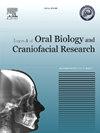近期生物陶瓷根管封闭剂的细胞毒性、细胞凋亡效应和再矿化潜力评估
Q1 Medicine
Journal of oral biology and craniofacial research
Pub Date : 2025-05-10
DOI:10.1016/j.jobcr.2025.05.002
引用次数: 0
摘要
本研究旨在评估ADseal(一种基于树脂的根管密封材料)和两种新近推出的生物陶瓷根管密封材料vdww .1 seal生物陶瓷和Fill root st的细胞毒性、细胞凋亡/坏死和钙离子释放。使用细胞活力MTT试验评估四种根管密封剂提取物浓度(100%、50%、25%和12.5%),并在所有浓度的24小时、48小时和7天后评估细胞活力。采用流式细胞术检测材料对细胞凋亡和坏死的影响。在蒸馏水中保存14天后,用光学发射光谱(ICP-OES)评估钙离子释放。采用双因素方差分析对所得结果进行统计分析。结果与ADseal封口剂相比,fill Root ST和vdww .1封口剂的细胞活力最高。此外,Fill Root ST,其次是vdww .1密封生物陶瓷,显示细胞凋亡和坏死减少。与生物陶瓷根管封口剂相比,VDW.1密封生物陶瓷的钙离子释放量最高,其次是Fill Root ST. ADseal封口剂的钙离子释放量最低。结论在细胞毒性、细胞凋亡/坏死和再矿化能力方面,生物陶瓷基根管密封材料比ADseal树脂基根管密封材料具有更好的生物相容性。本文章由计算机程序翻译,如有差异,请以英文原文为准。

Evaluation of the cytotoxicity, apoptotic effects, and remineralization potential of recent bioceramic-based root canal sealers
Background
This study is aimed at evaluating the cytotoxicity, apoptosis/necrosis, and calcium ion release of ADseal (a resin-based sealer) and two recently introduced bioceramic-based root canal sealers, which are VDW.1 seal bioceramic and Fill Root ST.
Methods
The cellular responses were studied in human periodontal ligament stem cells (hPDLSCs). Four root canal sealer extracts concentrations (100 %, 50 %, 25 %, and 12.5 %) were assessed for cell viability using the cell viability MTT essay and after 24 h, 48 h, and 7 days for all concentrations. To determine the effect of materials on apoptosis and necrosis, flow cytometry analysis was used. Calcium ion release was evaluated after 14 days of storage in distilled water using optical emission spectroscopy (ICP-OES). A two-way ANOVA was used for the statistical analysis of the acquired results.
Results
Fill Root ST and VDW.1 seal bioceramic showed the highest amount of cell viability compared to ADseal sealer. Moreover, Fill Root ST, followed by VDW.1 seal bioceramic, demonstrated decreased cell apoptosis and necrosis. Moreover, VDW.1 seal bioceramic showed the highest calcium ion release, followed by Fill Root ST. ADseal sealers showed the lowest calcium ion release compared to bioceramic-based root canal sealers.
Conclusions
Based on the results of this study, in terms of cytotoxicity, apoptosis/necrosis, and remineralization ability, bioceramic-based root canal sealers were more biocompatible than ADseal resin-based sealers.
求助全文
通过发布文献求助,成功后即可免费获取论文全文。
去求助
来源期刊

Journal of oral biology and craniofacial research
Medicine-Otorhinolaryngology
CiteScore
4.90
自引率
0.00%
发文量
133
审稿时长
167 days
期刊介绍:
Journal of Oral Biology and Craniofacial Research (JOBCR)is the official journal of the Craniofacial Research Foundation (CRF). The journal aims to provide a common platform for both clinical and translational research and to promote interdisciplinary sciences in craniofacial region. JOBCR publishes content that includes diseases, injuries and defects in the head, neck, face, jaws and the hard and soft tissues of the mouth and jaws and face region; diagnosis and medical management of diseases specific to the orofacial tissues and of oral manifestations of systemic diseases; studies on identifying populations at risk of oral disease or in need of specific care, and comparing regional, environmental, social, and access similarities and differences in dental care between populations; diseases of the mouth and related structures like salivary glands, temporomandibular joints, facial muscles and perioral skin; biomedical engineering, tissue engineering and stem cells. The journal publishes reviews, commentaries, peer-reviewed original research articles, short communication, and case reports.
 求助内容:
求助内容: 应助结果提醒方式:
应助结果提醒方式:


